width DODGE DURANGO 2021 Vehicle Warranty
[x] Cancel search | Manufacturer: DODGE, Model Year: 2021, Model line: DURANGO, Model: DODGE DURANGO 2021Pages: 262, PDF Size: 10.42 MB
Page 3 of 262
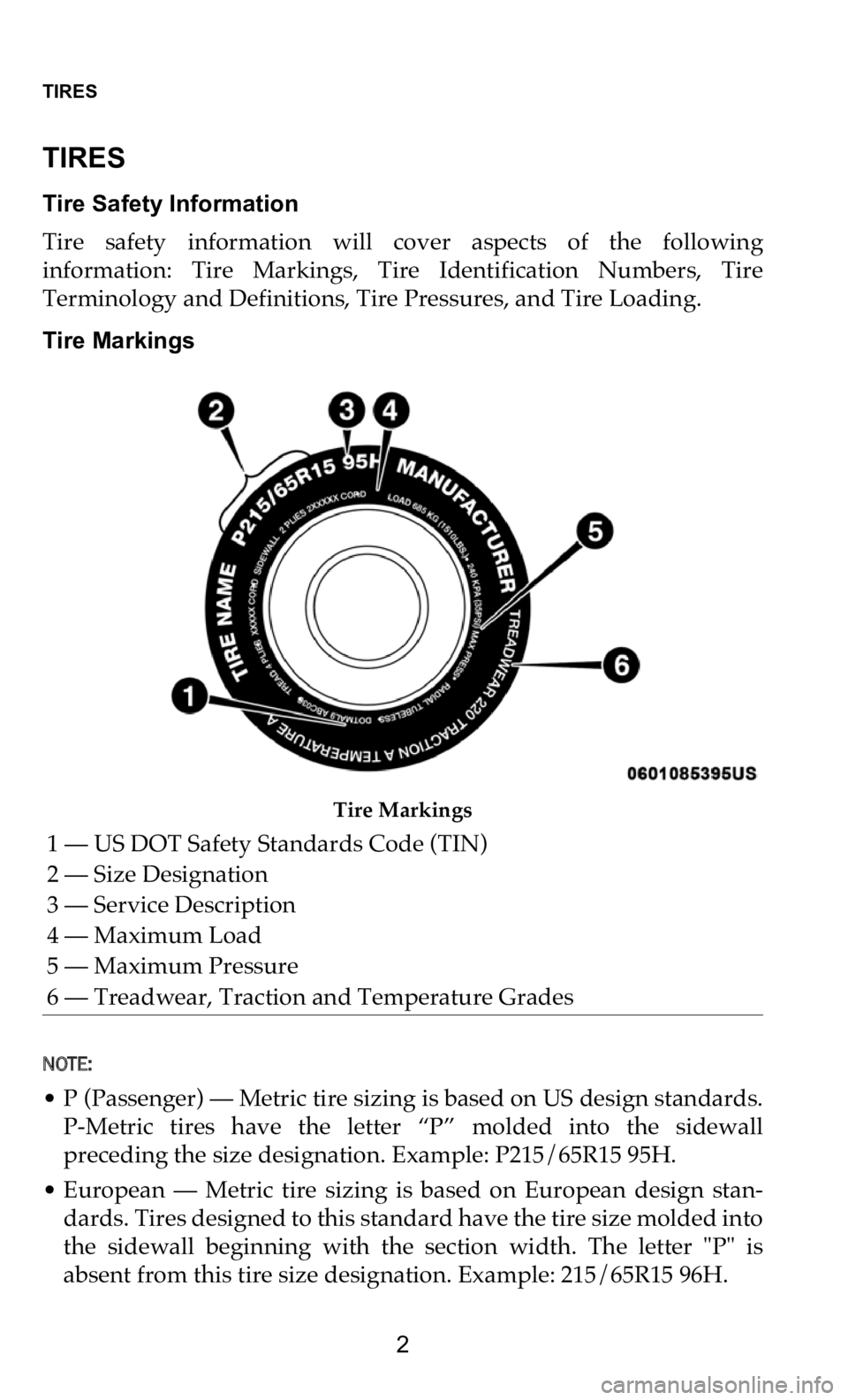
TIRES
2
TIRES
Tire Safety Information
Tire safety information will cover aspects of the following
in
formation: Tire Markings, Tire Identification Numbers, Tire
Terminology and Definitions, Tire Pressures, and Tire Loading.
Tire Markings
Tire Markings
NOTE:
• P (Passenger) — Metric tire sizing is based on US design standards.
P-Metric tires have the letter “P” molded into the sidewall
preceding the size designation. Example: P215/65R15 95H.
• European — Metric tire sizing is based on European design stan -
d
ards. Tires designed to this standard have the tire size molded into
th
e sidewall beginning with the section width. The letter "P" is
absent from this tire size designation. Example: 215/65R15 96H.
1 — US DOT Safety Standards Code (TIN)
2 — Size Designation
3 — Service Description
4 — Maximum Load
5 — Maximum Pressure
6 — Treadwear, Traction and Temperature Grades
Page 4 of 262

TIRES
3
• LT (Light Truck) — Metric tire sizing is based on US design stan -
dards. The size designation for LT-Metric tires is the same as for
P-
Metric tires except for the letters “LT” that are molded into the
sidewall preceding the size designation. Example: LT235/85R16.
• Temporary spare tires are designed for temporary emergency use
o
nly. Temporary high pressure compact spare tires have the letter
“T” or “S” molded into the sidewall preceding the size designation.
Example: T145/80D18 103M.
• High flotation tire sizing is based on US design standards and it
b
egins with the tire diameter molded into the sidewall. Example:
31x10.5 R15 LT.
Tire Sizing Chart
EXAMPLE:
Example Size Designation: P215/65R15XL 95H, 215/65R15 96H, LT235/85R16C,
T1
45/80D18 103M, 31x10.5 R15 LT
P = Passenger car tire size based on U.S. design standards, or
"....blank...." =
Passenger car tire based on European design standards, or
LT = Light Truck tire based on US design standards, or
T
or S = Temporary spare tire or
3
1 = Overall diameter in inches (in)
2
15, 235, 145 =
Section width in millimeters (mm)
65, 85, 80 = Aspect ratio in percent (%)
•
Ratio of section height to section width of tire, or
1
0.5 = Section width in inches (in)
R
= Construction code
• "R" means radial construction, or
•
"D" means diagonal or bias construction
1
5, 16, 18 = Rim diameter in inches (in)
S
ervice Description:
95 = Load Index
•
A numerical code associated with the maximum load a tire can carry
H
= Speed Symbol
• A symbol indicating the range of speeds at which a tire can carry a load corre -
s
ponding to its load index under certain operating conditions
• The maximum speed corresponding to the speed symbol should only be achieved
u
nder specified operating conditions (i.e., tire pressure, vehicle loading, road condi -
tions, and posted speed limits)
Page 63 of 262
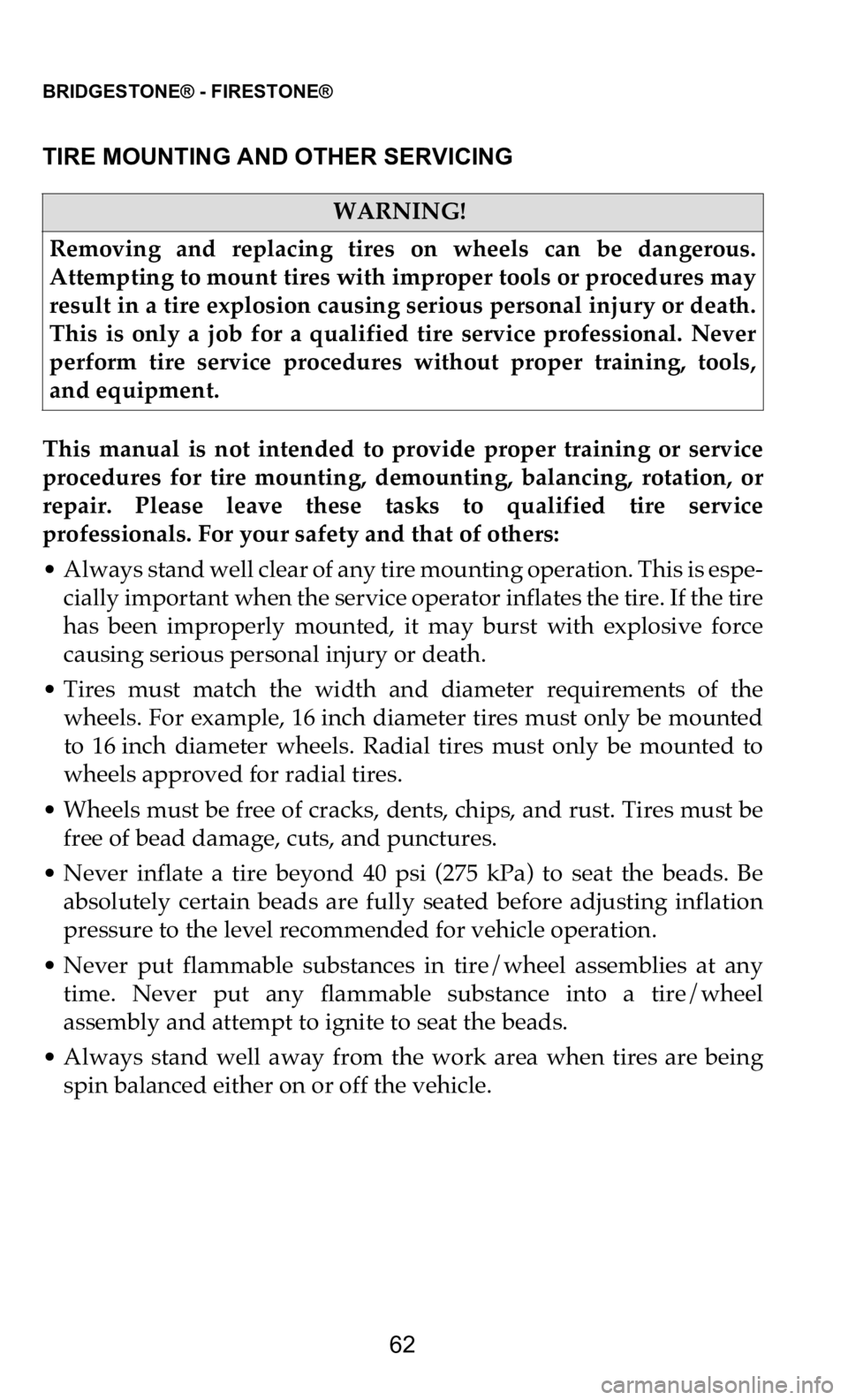
BRIDGESTONE® - FIRESTONE®
62
TIRE MOUNTING AND OTHER SERVICING
This manual is not intended to provide proper training or service
pr
ocedures for tire mounting, demounting, balancing, rotation, or
repair. Please leave these tasks to qualified tire service
professionals. For your safety and that of others:
• Always stand well clear of any tire mounting operation. This is espe -
c
ially important when the service operator inflates the tire. If the tire
ha
s been improperly mounted, it may burst with explosive force
causing serious personal injury or death.
• Tires must match the width and diameter requirements of the
w
heels. For example, 16 inch diameter tires must only be mounted
to
16 inch diameter wheels. Radial tires must only be mounted to
wh
eels approved for radial tires.
• Wheels must be free of cracks, dents, chips, and rust. Tires must be
f
ree of bead damage, cuts, and punctures.
• Never inflate a tire beyond 40 psi (275 kPa) to seat the beads. Be
a
bsolutely certain beads are fully seated before adjusting inflation
pressure to the level recommended for vehicle operation.
• Never put flammable substances in tire/wheel assemblies at any
t
ime. Never put any flammable substance into a tire/wheel
assembly and attempt to ignite to seat the beads.
• Always stand well away from the work area when tires are being
s
pin balanced either on or off the vehicle.
WARNING!
Removing and replacing tires on wheels can be dangerous.
At
tempting to mount tires with improper tools or procedures may
result in a tire explosion causing serious personal injury or death.
This is only a job for a qualified tire service professional. Never
perform tire service procedures without proper training, tools,
and equipment.
Page 127 of 262
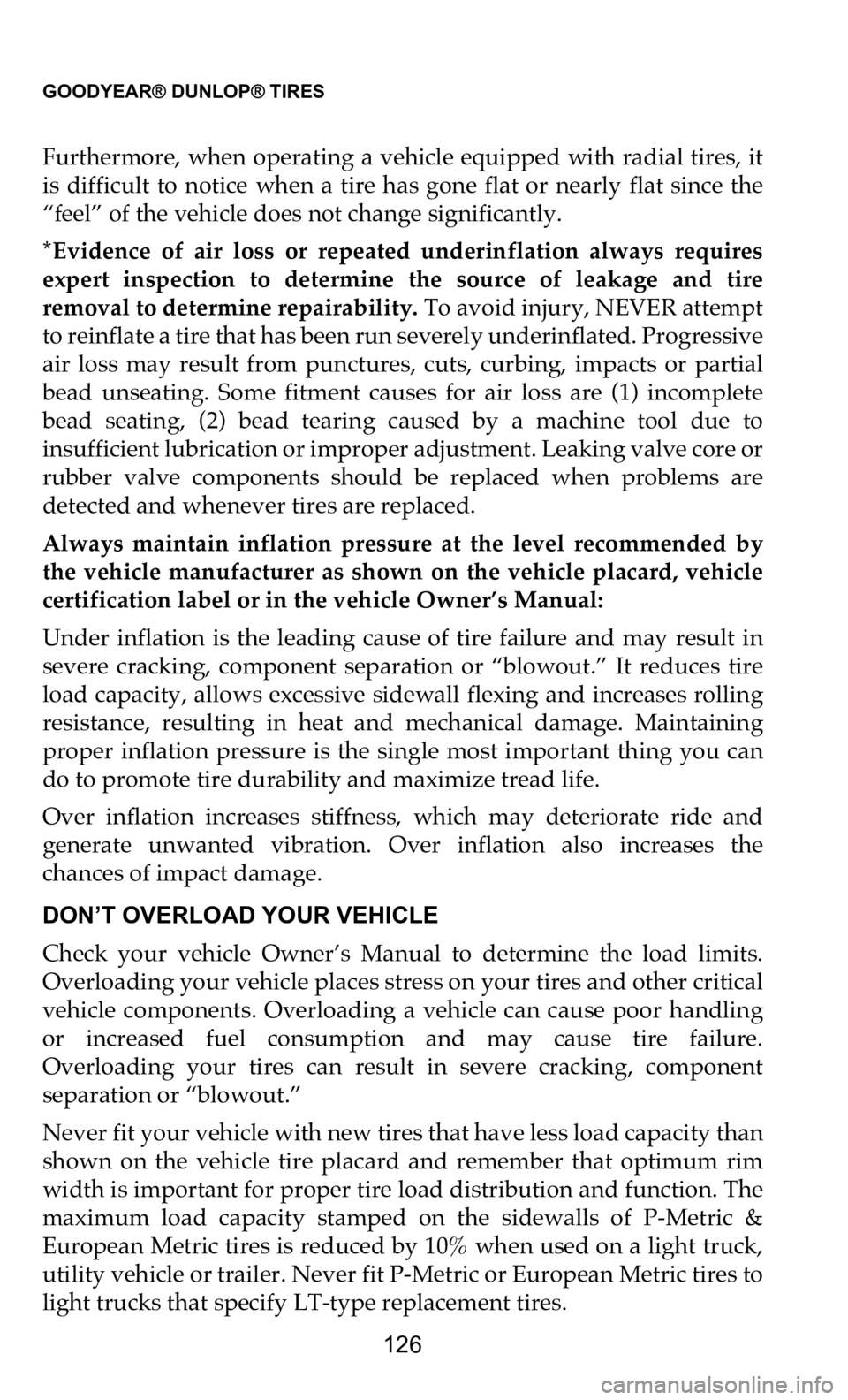
GOODYEAR® DUNLOP® TIRES
126
Furthermore, when operating a vehicle equipped with radial tires, it
is difficult to notice when a tire has gone flat or nearly flat since the
“feel” of the vehicle does not change significantly.
*Evidence of air loss or repeated underinflation always requires
ex
pert inspection to determine the source of leakage and tire
removal to determine repairability. To avoid injury, NEVER attempt
to reinflate a tire that has been run severely underinflated. Progressive
air loss may result from punctures, cuts, curbing, impacts or partial
bead unseating. Some fitment causes for air loss are (1) incomplete
bead seating, (2) bead tearing caused by a machine tool due to
insufficient lubrication or improper adjustment. Leaking valve core or
rubber valve components should be replaced when problems are
detected and whenever tires are replaced.
Always maintain inflation pressure at the level recommended by
t h
e vehicle manufacturer as shown on the vehicle placard, vehicle
certification label or in the vehicle Owner’s Manual:
Under inflation is the leading cause of tire failure and may result in
se
vere cracking, component separation or “blowout.” It reduces tire
load capacity, allows excessive sidewall flexing and increases rolling
resistance, resulting in heat and mechanical damage. Maintaining
proper inflation pressure is the single most important thing you can
do to promote tire durability and maximize tread life.
Over inflation increases stiffness, which may deteriorate ride and
ge
nerate unwanted vibration. Over inflation also increases the
chances of impact damage.
DON’T OVERLOAD YOUR VEHICLE
Check your vehicle Owner’s Manual to determine the load limits.
Ov
erloading your vehicle places stress on your tires and other critical
vehicle components. Overloading a vehicle can cause poor handling
or increased fuel consumption and may cause tire failure.
Overloading your tires can result in severe cracking, component
separation or “blowout.”
Never fit your vehicle with new tires that have less load capacity than
sh
own on the vehicle tire placard and remember that optimum rim
width is important for proper tire load distribution and function. The
maximum load capacity stamped on the sidewalls of P-Metric &
European Metric tires is reduced by 10% when used on a light truck,
utility vehicle or trailer. Never fit P-Metric or European Metric tires to
light trucks that specify LT-type replacement tires.
Page 130 of 262

GOODYEAR® DUNLOP® TIRES
129
When replacing tires, you must maintain the outside diameter and
load-carrying capacity of the Original Equipment tire. Inflation
pressure may need to be adjusted to avoid overloading the tire.
Consult the Tire & Rim Association Load and Inflation Tables,
European Tire and Rim Technical Organization (ETRTO) or Japan
Automobile Tyre Manufacturers Association (JATMA) standards for
correct load and inflation information.
NEVER FIT TIRES TO A VEHICLE THAT HAVE LESS
LO
AD-CARRYING CAPACITY THAN REQUIRED BY THE
ORIGINAL EQUIPMENT MANUFACTURER
Examples: Many vehicles, such as large passenger vans, require Load
Ra
nge E tires as designated by the vehicle manufacturer. Fitment of a
tire, such as a Load Range D, with less carrying capacity is not
allowed. In other cases, tires of the same size may carry different load
indexes in the service description. You must make certain the
replacement tires fitted to the vehicle have a load-carrying capacity
equal to or greater than what the Original Equipment manufacturer
specifies.
NOTE:
Goodyear® manufactured and/or marketed European- Metric
pa
ssenger tires and P-Metric passenger tires are interchangeable as
long as they have the same section width, same aspect ratio, same rim
diameter.
WARNING!
Before you replace your tires, always consult the vehicle owner’s
ma
nual and follow the vehicle manufacturer’s replacement tire
recommendations. Vehicle handling may be significantly affected
by a change in tire size or type. When selecting tires that are
different from the Original Equipment size, see a professional
installer in order to make certain that proper clearance,
load-carrying capacity and inflation pressure are selected. Never
exceed the maximum load capacity and inflation pressure listed
on the sidewall of the tire. Always drive safely and obey all traffic
laws. Avoid sudden, sharp turns or aggressive lane changes.
Failure to follow this warning may result in loss of control of the
vehicle, leading to an accident and serious injury or death.
Page 131 of 262
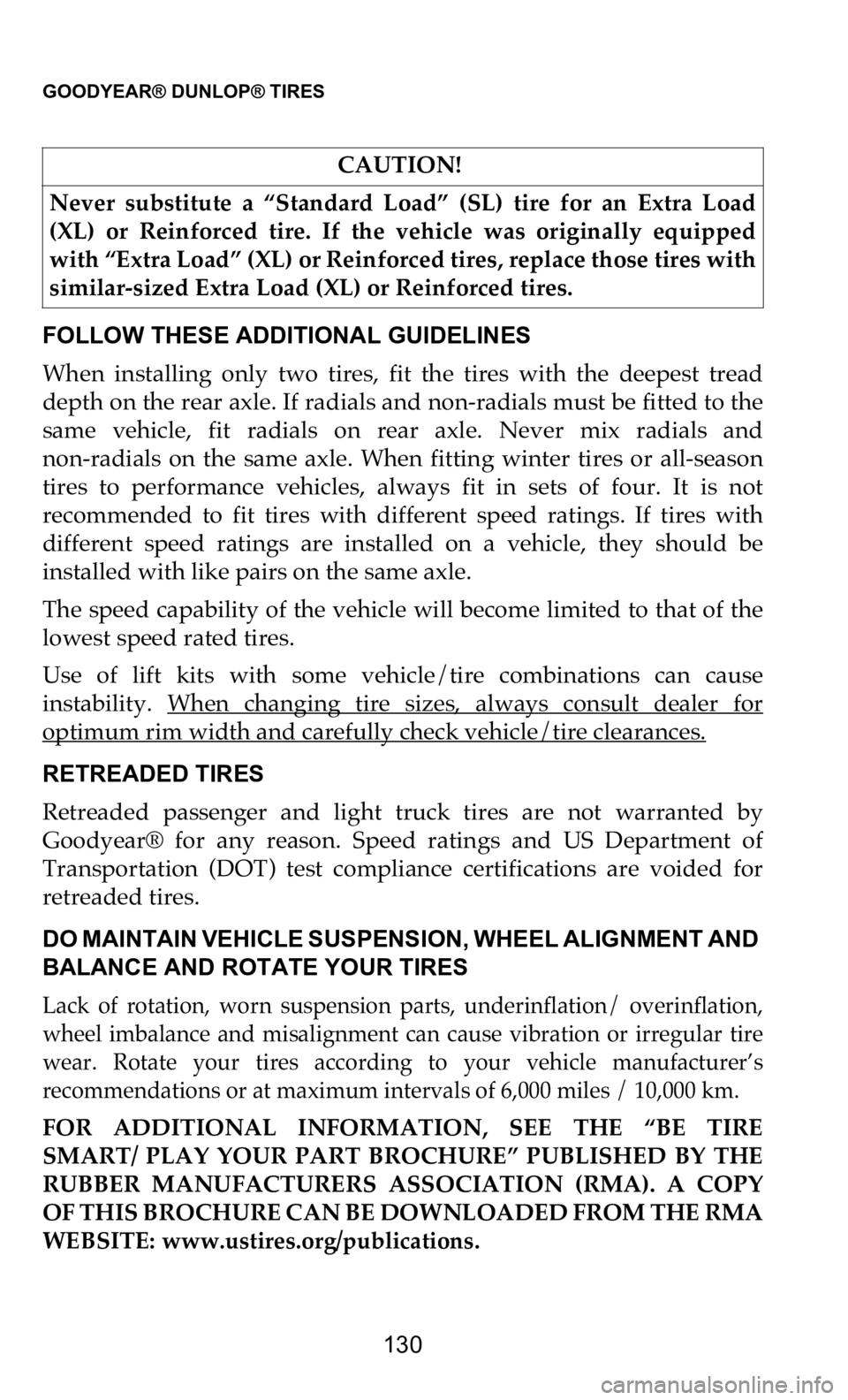
GOODYEAR® DUNLOP® TIRES
130
FOLLOW THESE ADDITIONAL GUIDELINES
When installing only two tires, fit the tires with the deepest tread
de
pth on the rear axle. If radials and non-radials must be fitted to the
same vehicle, fit radials on rear axle. Never mix radials and
non-radials on the same axle. When fitting winter tires or all-season
tires to performance vehicles, always fit in sets of four. It is not
recommended to fit tires with different speed ratings. If tires with
different speed ratings are installed on a vehicle, they should be
installed with like pairs on the same axle.
The speed capability of the vehicle will become limited to that of the
lo
west speed rated tires.
Use of lift kits with some vehicle/tire combinations can cause
in
stability. When changing tire sizes, always consult dealer for
optimum rim width and carefully check vehicle/tire clearances.
RETREADED TIRES
Retreaded passenger and light truck tires are not warranted by
Goodyear® for any reason. Speed ratings and US Department of
Transportation (DOT) test compliance certifications are voided for
retreaded tires.
DO MAINTAIN VEHICLE SUSPENSION, WHEEL ALIGNMENT AND
BA
LANCE AND ROTATE YOUR TIRES
Lack of rotation, worn suspension parts, underinflation/ overinflation,
whe
el imbalance and misalignment can cause vibration or irregular tire
wear. Rotate your tires according to your vehicle manufacturer’s
recommendations or at maximum intervals of 6,000 miles / 10,000 km.
FOR ADDITIONAL INFORMATION, SEE THE “BE TIRE
SM
ART/ PLAY YOUR PART BROCHURE” PUBLISHED BY THE
RUBBER MANUFACTURERS ASSOCIATION (RMA). A COPY
OF THIS BROCHURE CAN BE DOWNLOADED FROM THE RMA
WEBSITE:
www.ustires.org/publications
.
CAUTION!
Never substitute a “Standard Load” (SL) tire for an Extra Load
( X
L) or Reinforced tire. If the vehicle was originally equipped
with “Extra Load” (XL) or Reinforced tires, replace those tires with
similar-sized Extra Load (XL) or Reinforced tires.
Page 230 of 262
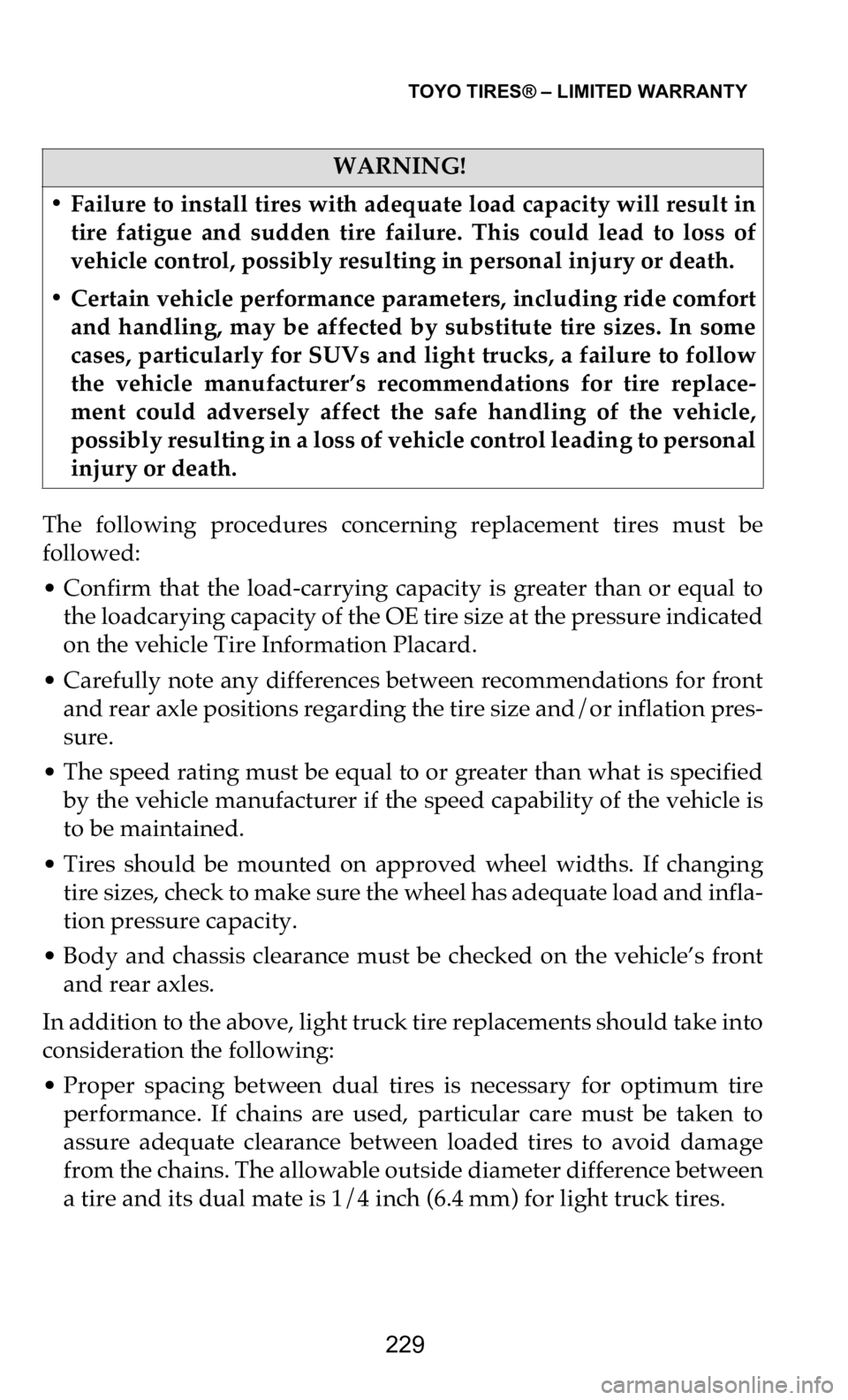
TOYO TIRES® – LIMITED WARRANTY
229
The following procedures concerning replacement tires must be
followed:
• Confirm that the load-carrying capacity is greater than or equal to
t
he loadcarying capacity of the OE tire size at the pressure indicated
on the vehicle Tire Information Placard.
• Carefully note any differences between recommendations for front
a
nd rear axle positions regarding the tire size and/or inflation pres-
sure.
• The speed rating must be equal to or greater than what is specified
b
y the vehicle manufacturer if the speed capability of the vehicle is
to be maintained.
• Tires should be mounted on approved wheel widths. If changing
t
ire sizes, check to make sure the wheel has adequate load and infla -
tion pressure capacity.
• Body and chassis clearance must be checked on the vehicle’s front
a
nd rear axles.
In addition to the above, light truck tire replacements should take into
co
nsideration the following:
• Proper spacing between dual tires is necessary for optimum tire
p
erformance. If chains are used, particular care must be taken to
assure adequate clearance between loaded tires to avoid damage
from the chains. The allowable outside diameter difference between
a tire and its dual mate is 1/4 inch (6.4 mm) for light truck tires.
WARNING!
• Failure to install tires with adequate load capacity will result in
t
ire fatigue and sudden tire failure. This could lead to loss of
vehicle control, possibly resulting in personal injury or death.
• Certain vehicle performance parameters, including ride comfort
a
nd handling, may be affected by substitute tire sizes. In some
cases, particularly for SUVs and light trucks, a failure to follow
the vehicle manufacturer’s recommendations for tire replace -
ment could adversely affect the safe handling of the vehicle,
po
ssibly resulting in a loss of vehicle control leading to personal
injury or death.
Page 231 of 262
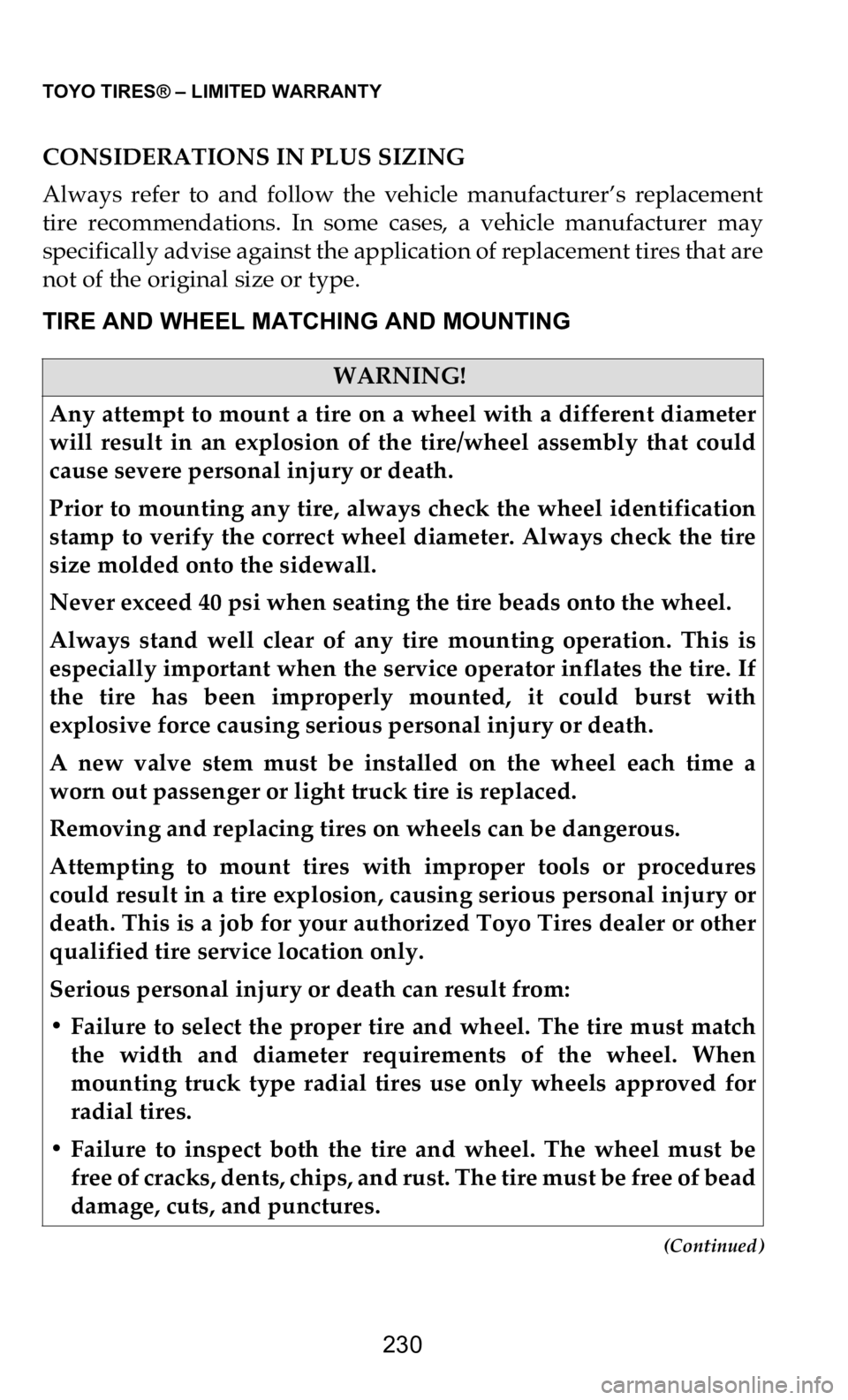
TOYO TIRES® – LIMITED WARRANTY
230
(Continued)
CONSIDERATIONS IN PLUS SIZING
Always refer to and follow the vehicle manufacturer’s replacement
ti
re recommendations. In some cases, a vehicle manufacturer may
specifically advise against the application of replacement tires that are
not of the original size or type.
TIRE AND WHEEL MATCHING AND MOUNTING
WARNING!
Any attempt to mount a tire on a wheel with a different diameter
wi
ll result in an explosion of the tire/wheel assembly that could
cause severe personal injury or death.
Prior to mounting any tire, always check the wheel identification
st
amp to verify the correct wheel diameter. Always check the tire
size molded onto the sidewall.
Never exceed 40 psi when seating the tire beads onto the wheel.
Always stand well clear of any tire mounting operation. This is
es
pecially important when the service operator inflates the tire. If
the tire has been improperly mounted, it could burst with
explosive force causing serious personal injury or death.
A new valve stem must be installed on the wheel each time a
wo
rn out passenger or light truck tire is replaced.
Removing and replacing tires on wheels can be dangerous.
Attempting to mount tires with improper tools or procedures
co
uld result in a tire explosion, causing serious personal injury or
death. This is a job for your authorized Toyo Tires dealer or other
qualified tire service location only.
Serious personal injury or death can result from:
• Failure to select the proper tire and wheel. The tire must match
t
he width and diameter requirements of the wheel. When
mounting truck type radial tires use only wheels approved for
radial tires.
• Failure to inspect both the tire and wheel. The wheel must be
f
ree of cracks, dents, chips, and rust. The tire must be free of bead
damage, cuts, and punctures.